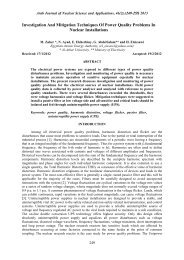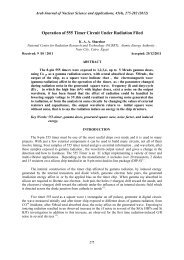Download - Arab Journal of Nuclear Sciences and Applications
Download - Arab Journal of Nuclear Sciences and Applications
Download - Arab Journal of Nuclear Sciences and Applications
Create successful ePaper yourself
Turn your PDF publications into a flip-book with our unique Google optimized e-Paper software.
<strong>Arab</strong> <strong>Journal</strong> <strong>of</strong> <strong>Nuclear</strong> Science <strong>and</strong> <strong>Applications</strong>, 46(1), (282-296)2013<br />
It seems feasible that fluconazole becomes teratogenically operative only under high levels <strong>of</strong><br />
exposure because no increment in congenital malformations have been reported after exposure to a<br />
single dose or multiple doses <strong>of</strong> 5-20 mg/day (4) . Several congenital anomalies were observed in<br />
children delivered from mother treated with fluconazole at doses <strong>of</strong> 400-800 mg/d <strong>and</strong> these anomalies<br />
were similar to those observed in animal studies. These anomalies including crani<strong>of</strong>acial, limb,<br />
brachycephaly, cleft palate, skeletal thin ribs, lo ng bones, ossification defects, kidney <strong>and</strong> cardiac<br />
defects (5-6) . In addition, the teratogenicity <strong>of</strong> fluconazole in animals might be dose-dependent.<br />
Tachibana, (7) stated that when pregnant rats were treated with 25 or 125 mg/Kg during days 6-17 <strong>of</strong><br />
gestation an increased occurrence <strong>of</strong> fetal anatomical variants including renal pelvis dilation <strong>and</strong><br />
cardiac deformation (at 125 mg/Kg) <strong>and</strong> supernumeraty ribs (at 25 <strong>and</strong> 125 mg/Kg) were noted.<br />
Moreover, doses ranging from 80 to 320 mg/Kg on gestational day 6 to 17 resulted in increased in<br />
embryoletality, high incidence fetal resorption as well as significant number <strong>of</strong> stillbirth <strong>and</strong> fetal<br />
abnormalities including wavey ribs <strong>and</strong> abnormal limbs <strong>and</strong> crani<strong>of</strong>acial ossifications (8) . Maternal<br />
weight loss was impaired <strong>and</strong> placental weights were increased after exposure to fluconazole at doses<br />
<strong>of</strong> 25 to 50 mg/Kg <strong>and</strong> higher (9) . Furthermore, at doses <strong>of</strong> 50µg/ml <strong>of</strong> fluconazole <strong>and</strong> 75µg/ml<br />
morphogenesis was impaired as demonstrated by skeletal anomalies that developed from the second<br />
branchial arch (10) . The branchial arches are transitional embryonic structure involved in the<br />
development <strong>of</strong> several components <strong>of</strong> the head <strong>and</strong> neck (11). Moreover, oxidative stress associated<br />
with fluconazole induced organ injury (12) . Lipid peroxidation is one <strong>of</strong> the most investigated<br />
consequences <strong>of</strong> reactive oxygen substances on membrane structure <strong>and</strong> function, it is also involved in<br />
the development <strong>of</strong> tissue injury in various biosystems (13) . Hua, (14) stated that fluconazole penetrated<br />
the central nervous system to the brain when rats treated with it at doses 10-20 mg/Kg <strong>and</strong> induced<br />
impairment in the brain tissues. In addition, fluconazole have been reported to affect the muscle<br />
membrane through Na + /K + pump <strong>and</strong> membrane electrical properties <strong>and</strong> fluidity (15) .<br />
On the other h<strong>and</strong>, the steadily increasing use <strong>of</strong> nuclear <strong>and</strong> radiation technology extended to<br />
different fields, which have paralled by increasing potential risk for radiation exposure (16) . The<br />
deletrious effects <strong>of</strong> ionizing radiation on biological system are mainly mediated through the<br />
generation <strong>of</strong> reactive oxygen species (ROS) in cells as a result <strong>of</strong> water radiolysis (17) . ROS <strong>and</strong><br />
oxidative stress may contribute to metabolic <strong>and</strong> morphologic changes in human <strong>and</strong> animals (18) . The<br />
uncontrolled ROS production could induce modification <strong>of</strong> lipids which play a role in the development<br />
<strong>of</strong> cardiovascular (19) <strong>and</strong> neurodegenerative damage (20) . Maternal exposure to γ-radiation at the dose 3<br />
Gy on the 6 th <strong>and</strong> 12 th days <strong>of</strong> gestation induced pre-implantation death, increased incidence <strong>of</strong> intrauterine<br />
death, reduced the rate <strong>of</strong> growth as well as uterine retardation (21) . Ramadan (22) recorded that<br />
pregnant rats exposed to 3 Gy γ-irradiation on the 7 th , 11 th <strong>and</strong> 15 th days <strong>of</strong> gestation induced<br />
deformations in the skeletal system. Also, exposure to ionizing radiation induced oxidative stress in<br />
various organs, altering the cell membrane potential <strong>and</strong> these alterations may influence the<br />
biochemical parameters, enzyme activities (23) , K + , <strong>and</strong> Na + levels (23) , lipid peroxidation (24) <strong>and</strong><br />
histopathological disorders mainly in the heart (25) <strong>and</strong> brain cells (26) .<br />
In view <strong>of</strong> this consideration, the current study has been designed to investigate the adverse<br />
effect <strong>of</strong> fluconazole administration with radiation exposure to pregnant rats <strong>and</strong> the development <strong>of</strong><br />
their fetuses. This was assessed biochemically by estimating malondialdehyde (MDA) <strong>and</strong> NO in the<br />
tissues <strong>of</strong> heart <strong>and</strong> brain , LDH, CKP <strong>and</strong> AST in the serum <strong>of</strong> pregnant rats, structural changes in the<br />
heart <strong>and</strong> brain <strong>of</strong> their fetuses as well as selected skeletal <strong>and</strong> morphological defects in fetuses.<br />
283












